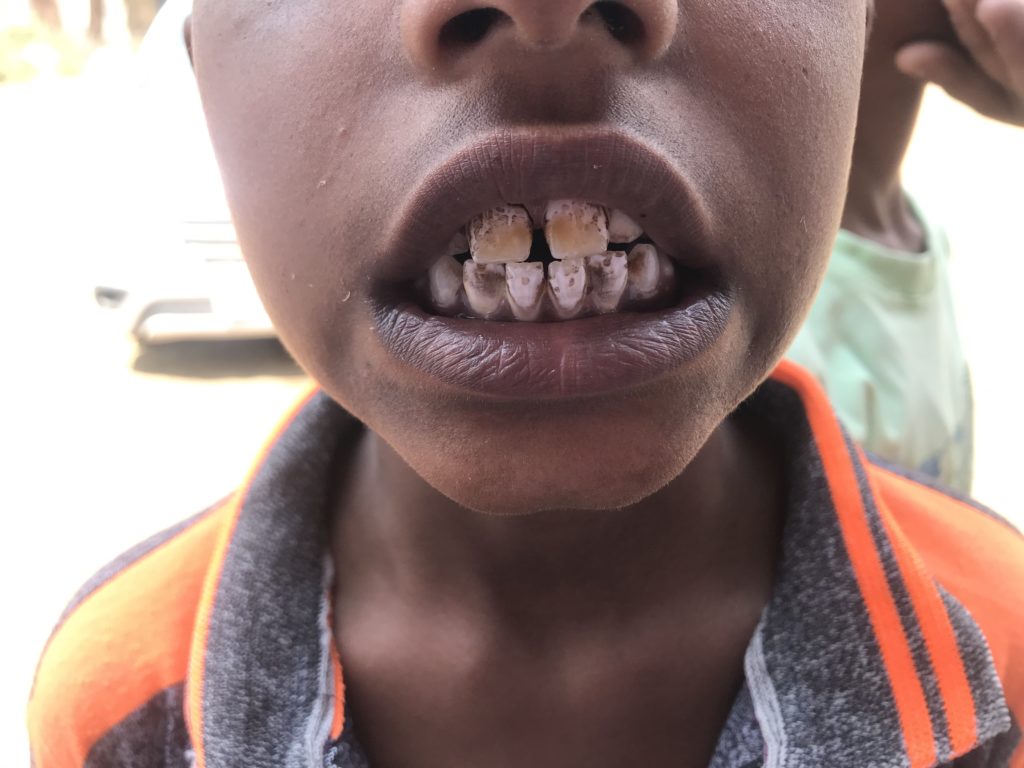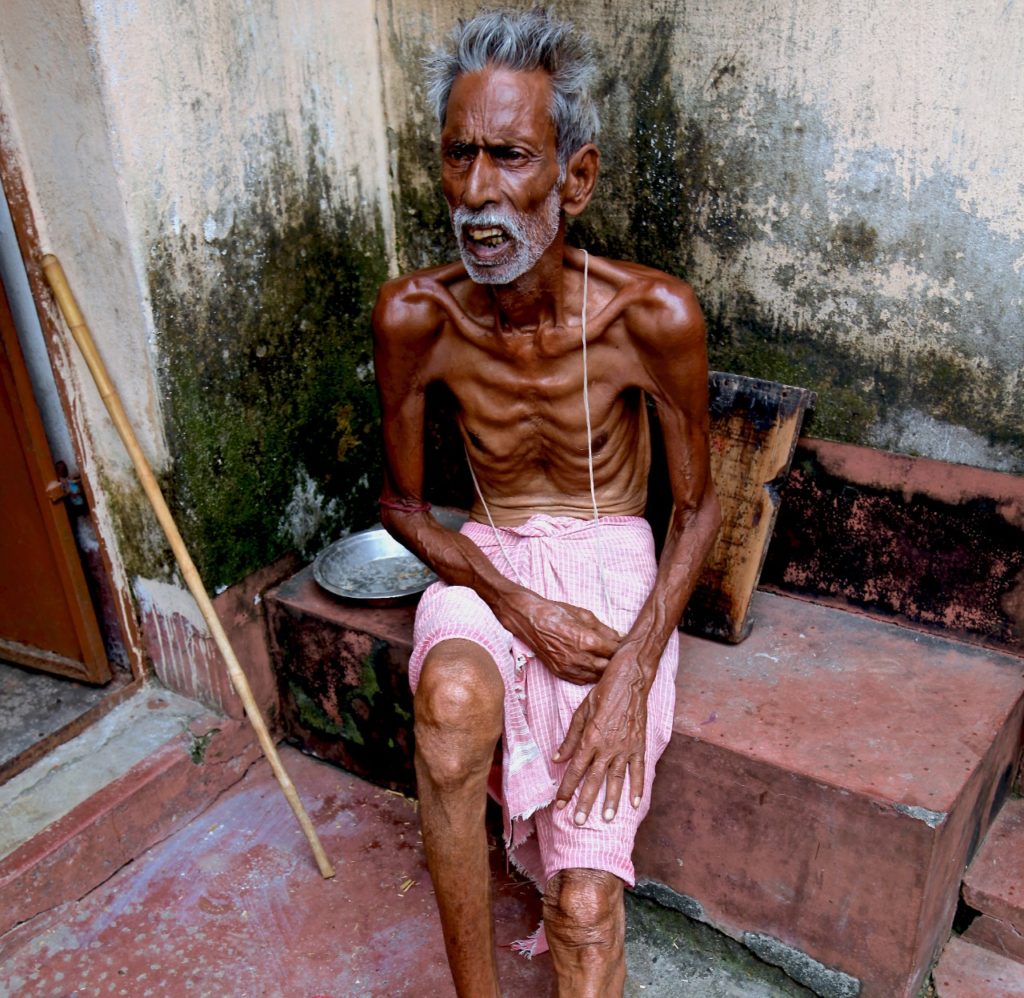Mystery of the poisoned waters: 2/3rd arsenic, fluoride-hit habitations safe now — despite budgets unspent
Till last June, there were 13,972 arsenic-affected habitations in India, now down to 4,588, a drop of 67% in a year. Fluoride-affected habitations have declined by 34% in a year. Gaon Connection’s deep dive into official data.


Fluorosis has crippled Himanshu Chakarbarty, a resident of high fluoride-affected Brahman Tola in Dhanbad district, Jharkhand. Pic: Eklavya Prasad
For at least 28 million people living in more than 53,000 habitations spread across 21 states in India, every sip of water is but slow poison. Their drinking water sources are contaminated with various toxic pollutants, including high levels of cancer-causing arsenic, and fluoride, which deforms bones and cripples them for life.
In Dakshin Dinajpur district of West Bengal, about 400 kilometres from the state capital Kolkata, at least one member of each household in Gangarampur block displays symptoms of fluorosis, an irreversible disease caused due to ingestion of high fluoride. Children have stained teeth, while the inability to walk has seen some drop out of school.
“Fluorosis is no longer endemic in the area; it is turning out to be an epidemic,” Tuhin Subhra Mandal, secretary of Dishari Sankolpo, a local not-for-profit, told Gaon Connection.
As per the latest data shared recently by Rattan Lal Kataria, the minister of state in the Union Ministry of Jal Shakti in a Lok Sabha reply, every day, residents of at least 10,200 habitations in 17 states of the country drink water laced with high arsenic and fluoride, slow poisons that cripple and kill people.
Interestingly, just four years ago, as per 2016 data provided by the Central government’s department of drinking water and sanitation, India had 13,725 habitations with excess fluoride (more than 1.5 milligram per litre), of which nearly 50 per cent were in Rajasthan alone. Around 13,819 habitations were affected by high arsenic (more than 0.01 milligram per litre) in their water. Of this, 85 per cent were in West Bengal and Assam.
But now, there seems to be a drastic decline in arsenic and fluoride affected habitations in the country. For instance, from 13,819 arsenic-affected habitations in 2016, the numbers are down to 4,588 till August 1 this year (67 per cent reduction). Similarly, fluoride-affected habitations have dropped from 13,725 in 2016 to 5,632 in August 2020 (59 per cent reduction).

Official data accessed by Gaon Connection shows that on the one hand, insufficient funds were released for drinking water supply projects, and a majority of it remained unspent. On the other hand, there is a huge reduction in affected habitations.
For instance, of the total Rs 25,000 crore cost of this National Water Quality Sub Mission on Arsenic and Fluoride, half the money had to come from the Central government. But, with just five months to go for the March 2021 deadline, only Rs 3,940 crore, or 32 per cent, of the estimated Central share has been released. Also, of the money released, only Rs 2,750 crore has been used by the state governments and 30 per cent remains unspent.
Central funds unspent
It was in March 2017 that the Indian government launched the National Water Quality Sub-Mission on Arsenic and Fluoride to provide safe drinking water to about 28,000 fluoride- and arsenic-affected habitations by March 2021. This was to be done through piped water schemes or short-term community water purification plants. The mission was launched under the National Rural Drinking Water Programme (now subsumed by Jal Jeevan Mission), which aims to provide functional household tap connection to all households by 2024.
The estimated cost of this National Water Quality Sub Mission was Rs 25,000 crore. This money was supposed to be spent over a period of four years, that is by March 2021, when all the affected habitations are expected to have access to safe drinking water.
Of the total Rs 25,000 crore, the Central government’s share was Rs 12,500 crore, and the remaining had to come from the respective state governments. In the case of Himalayan states and those in the northeast region, the sharing formula was 90:10 (Centre:State).
However, with just six months to go for the March 2021 deadline, only Rs 3,940 crore, or 32 per cent, of the estimated Central share has been released. A majority of this was done till the 2018-19 fiscal. No funds were allocated for the 2019-20 and 2020-21 fiscals, except for the state of Rajasthan that received Rs 250 crore in the last financial year.
Data accessed by Gaon Connection shows that of the Rs 3,940 crore released by the Centre, only Rs 2,750 crore has been used by the state governments and 30 per cent remains unspent (see graphic: Funds released by Centre and states under NWQSM).
Of the 16 states that were allocated funds by the Centre under the National Water Quality Sub Mission, only two — Telangana and Odisha — have fully utilised their share. Meanwhile, five affected states have more than 60 per cent of funds lying unspent — Andhra Pradesh, Assam, Karnataka, Maharashtra and Punjab.
However, despite unspent funds and no additional allocations for two years from the Centre, a drastic fall in the number of affected habitations has been observed (see graphic).
For instance, Karnataka, which has 92 per cent unspent Central funds, has recorded a drop of 83 per cent, from 1,038 fluoride-affected habitations in 2016 to 177 in 2020. Arsenic affected habitations in the state have reduced from 21 in 2016 to zero in 2020!
According to L K Atheeq, principal secretary, rural development, Government of Karnataka, the Central government has been a small funder of drinking water supply for years. With Jal Jeevan Mission, the funding for the water sector has been enhanced. “The Government of India’s allocation under the National Rural Drinking Water Project was around Rs 700 crore to Karnataka out of which Rs 325 crore was the Centre’s share,” he told Gaon Connection.
“The National Water Quality Sub Mission was a very small window and around Rs 26 crore released to the state could not be utilised as Karnataka had already covered most of the water quality affected habitation,” he added.
According to him, the state government has been investing Rs 2,600 to Rs 3,000 crore every year for the past several years from its own resources. “So with our own funds, we have taken up pure drinking water supply projects from surface water sources. We have also installed about 18,000 water treatment plants to reduce chemically-affected habitations,” he said.
Bengaluru-based Karthik Seshan, who has worked on water-related issues, especially in Chikkaballapur district of Karnataka, said that while the change in numbers of affected habitations is drastic in Karnataka, a possible scenario that led to this could be the wide installation of reverse osmosis (RO) plants across the state, resulting in classification of these habitations as safe.
However, as per a news report, about 5,000 such plants in the state were found defunct. “So, the figures [decline in affected habitations] might reflect project achievements, but need to be taken with a pinch of salt,” said Seshan.
Interestingly, in Assam, with 70 per cent unspent fund, the number of arsenic-affected habitations has declined sharply after a rise. For instance, arsenic-affected habitations in the state increased from 3,726 in 2016 to 4,293 in 2019. But, have dropped to 2,006 in 2020. Similarly, fluoride-affected habitations in the state rose from 155 in 2016 to 256 in 2019, but now stand at 34 only.
Rajasthan, with an estimated project cost of Rs 4,463 crore, spent only Rs 652 crore from the state budget, which is nearly 29 per cent of the state’s share. Meanwhile, it still has nearly 33 per cent of the total Central fund unspent. However, fluoride affected habitations have dropped from 6,849 habitations in 2016 to 3,095 in 2020 — a drop of 55 per cent in four years.
In the case of Jharkhand, the estimated cost of water supply project under the sub-mission was Rs 826 crore and it spent only Rs 53 crore. But, the number of fluoride-affected habitations has dropped by a whopping 92 per cent — from 998 in 2016 to 81 in 2020. Similarly, arsenic-affected habitations have dropped from 130 to 2 in the same time period.
Overall, an analysis of Lok Sabha responses over the last four years shows a 59 per cent decline in fluoride-affected areas and a 67 per cent decline in habitations contaminated by arsenic in the country.
Both fluoride and arsenic are naturally occurring contaminants and their consumption beyond the permissible limit — 1.5 milligram/litre and 0.01 milligram/litre respectively — is harmful. Moderate ingestion of fluoride can lead to staining of teeth and destroy the enamel, a condition called dental fluorosis. Ingested in large quantities, fluoride accumulates in the bones, leading to skeletal fluorosis. Excess arsenic ingestion has been linked to skin lesions and cancer in the bladder, kidney and lungs.
States funds unspent too
Of the total Rs 25,000 crore under the National Water Quality Sub-Mission, half the funds had to come from the Centre and the rest from the state governments. As far as the latter’s share is concerned, only Rs 2,021 crore has been spent from state budgets, amounting to 16 per cent of the state’s share in the sub mission.
Five affected states — Assam, Chhattisgarh, Karnataka, Maharashtra and Punjab — failed to spend even one per cent of their respective shares.
Telangana, the only state which was able to bring down the fluoride-contaminated habitations from 967 in 2015 to zero in August 2020, received Rs 700 crore from the Centre and spent another Rs 505 crore from its own budget.
Punjab was allocated Rs 98 crore. It was only in the financial year 2020-21 that Rs 18 crore was spent from the central fund and Rs 82 lakh from the state budget. Meanwhile, the number of arsenic affected habitations in the state has jumped from 492 in 2016 to 616 in August 2020. However, fluoride affected habitations have dropped from 285 to 211 in the same time period.
“Telangana was able to perform well because it is a new state and there was a political mandate for fluoride-free water, especially in Nalgonda district. The state was in a position to avail loans from banks because the scale of money that is required is huge,” Sunderrajan Krishnan, executive director of Gujarat-based research organisation, India Natural Resource Economics and Management Foundation, told Gaon Connection.
In August 2016, Telangana initiated its ambitious ‘Mission Bhagiratha’ to provide safe drinking water to all habitations at a massive outlay of Rs 45,028 crore. However, piped water supply is a difficult task to implement, explained Krishnan. “The actual cost of piped water schemes is more than what the Centre is ready to give. There are several other expenses that states have. There is the cost of constructing pipelines in villages, making people accept the concept and finally being able to maintain the pipelines,” he said.
Interestingly, in case of arsenic-affected habitations, a major percentage of the decline is observed between 2019 and 2020. As per a Lok Sabha question reply on July 4, 2019, there were 13,972 arsenic affected habitations in the country till June 27, 2019. This has suddenly dwindled to 4,588 in 2020. A drastic decline of 67 per cent within a year!
Similarly, between last year and this year, fluoride-affected habitations have declined from 8,526 to 5,632, a drop of 34 per cent.

Gaon Connection contacted a number of senior officials at the Department of Drinking Water and Sanitation, including M H Renjitha, deputy secretary of Jal Jeevan Mission and Pradeep Singh, director, Jal Jeevan Mission, with a detailed questionnaire for a response to this article. So far, there has been no reply. The article will be updated when a response is received.
Meanwhile, A B Paul, retired chief engineer of Public Health Engineering Department, Assam, told Gaon Connection that he doesn’t agree with the figures being reported. “If there are 700 arsenic-contaminated habitations in a given year, the next year the department might say it has reduced to 500, as 200 habitations have been given safe water. But that doesn’t mean there is no arsenic in those 200 habitations,” he explained.

